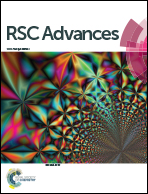Syntheses, structures, electrochemical and optical properties of four transition metal complexes based on the 1-triazolyl-3-benzimidazolyltriazene ligand†
Abstract
Four transition metal complexes based on the 1-triazolyl-3-benzimidazolyltriazene (H3TBIT) ligand of [Co(H2TBIT)(HTBIT)] (1), {[Cu(H2TBIT)(SCN)]·H2O} (2), [Cd2(H3TBIT)2(H2O)2Cl4] (3) and {[Ni3(H2TBIT)2(HTBIT)2(en)2]·IPA·2H2O} (en = ethylenediamine, IPA = isopropanol) (4) have been synthesized and characterized by single crystal X-ray diffraction analysis. In 1–4, the triazene ligand acts in different coordinating or bridging modes resulting in two mononuclear structures for 1 and 2, one dinuclear structure for 3 and one trinuclear structure for 4. Different structural 1–4 are further self-assembled through hydrogen bonds or π–π, C–H⋯π or metal–π interactions to form 3D supramolecular structures. The electrochemical properties in aqueous solutions as well as the photoluminescent properties in ethanol of H3TBIT and 1–4 are investigated. The TD-DFT calculations at the B3LYP/6-311++G(d,p) level for H3TBIT has been used to demonstrate the characteristic absorption spectrum.


 Please wait while we load your content...
Please wait while we load your content...